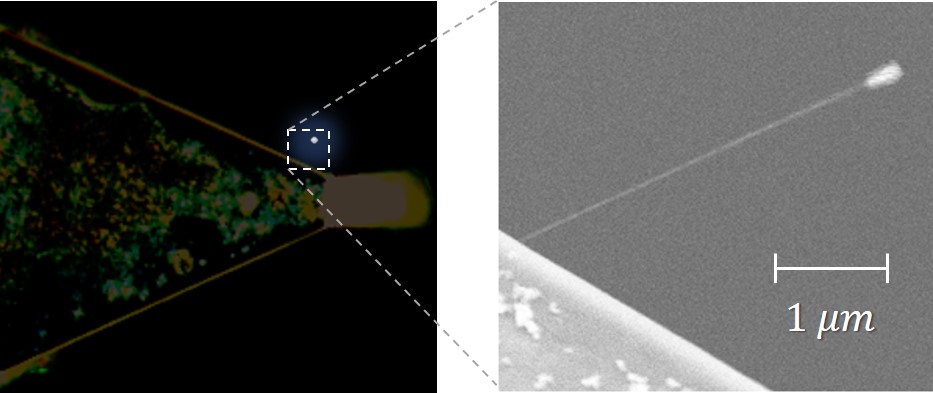
Nanotubes ultra – bas bruit
Ultra – low noise nanotubes
Pierre Verlot (équipe Luminescence), en collaboration avec des collègues de Barcelone, a publié un article intitulé "Optomechanics with a hybrid carbon nanotube resonator" dans la revue Nature Communications.
Pierre Verlot (Luminescence team), in collaboration with colleagues from Barcelona, published an article entitled "Optomechanics with a hybrid carbon nanotube resonator" in the journal Nature Communications.
Les nanotubes de carbone ont récemment émergé comme famille de systèmes mécaniques résonants présentant un très haut potentiel pour une large gamme d’applications ultra – sensibles telles que la spectroscopie de masse, la microscopie de surface et les mesures de forces ultra-faibles. Du fait de leur très faible masse, les moindres changements de leur environnement sont susceptibles de largement impacter leurs vibrations. Toutefois jusqu’alors, la détection de ces vibrations ne pouvait s’effectuer qu’à partir de sondes électromécaniques, essentiellement dans des conditions de très basse température, ce qui en limite très fortement le champ d’application.
Les auteurs ont développé un nouveau système simple permettant la détection des vibrations de nanotubes de carbone (diamètre de l’ordre de 1 nm, longueur de l’ordre de 1 micromètre), avec une très grande sensibilité. Cette approche leur a permis de calibrer avec une très grande précision le bruit thermique de ces objets vibrants. Ils ont ainsi pu démontrer que les nanotubes de carbone correspondent aux systèmes mécaniques présentant le bruit thermique le plus faible jamais mesuré, plus de deux ordres de grandeur inférieur au précédent record.
Les auteurs ont développé un nouveau système simple permettant la détection des vibrations de nanotubes de carbone (diamètre de l’ordre de 1 nm, longueur de l’ordre de 1 micromètre), avec une très grande sensibilité. Cette approche leur a permis de calibrer avec une très grande précision le bruit thermique de ces objets vibrants. Ils ont ainsi pu démontrer que les nanotubes de carbone correspondent aux systèmes mécaniques présentant le bruit thermique le plus faible jamais mesuré, plus de deux ordres de grandeur inférieur au précédent record.
Carbon nanotubes have recently emerged as a class of resonant mechanical system with a very high potential for a large panel of ultra-sensitive applications, such as mass spectroscopy, surface microscopy and ultra-low forces measurement. Because of their ultra-low mass, the tiniest change in their environment results in large consequences on their vibrations. However so far, detecting these vibrations could be only achieved by means of electromechanical probes and essentially at very low temperature, which was strongly limiting the perspectives of application.
The authors have developed a new system enabling the detection of the vibrations of suspended carbon nanotubes (diameter on the order of 1 nm, length on the order of 1 micrometre), with a very high sensitivity. Using this approach, they have calibrated the thermal noise of carbon nanotube resonators with a very high sensitivity. They demonstrate that carbon nanotube resonators are the mechanical systems with the lowest ever measured thermal noise, more than two orders of magnitude below the previous state of the art.
The authors have developed a new system enabling the detection of the vibrations of suspended carbon nanotubes (diameter on the order of 1 nm, length on the order of 1 micrometre), with a very high sensitivity. Using this approach, they have calibrated the thermal noise of carbon nanotube resonators with a very high sensitivity. They demonstrate that carbon nanotube resonators are the mechanical systems with the lowest ever measured thermal noise, more than two orders of magnitude below the previous state of the art.


















